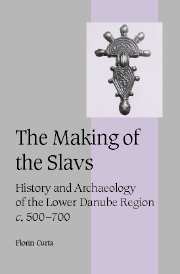Book contents
- Frontmatter
- Contents
- List of figures
- List of tables
- Acknowledgments
- List of abbreviations
- Introduction
- 1 Slavic ethnicity and the ethnie of the Slavs: concepts and approaches
- 2 Sources for the history of the early Slavs (c. 500–700)
- 3 The Slavs in early medieval sources (c. 500–700)
- 4 The Balkans and the Danube limes during the sixth and seventh centuries
- 5 Barbarians on the sixth-century Danube frontier: an archaeological survey
- 6 Elites and group identity north of the Danube frontier: the archaeological evidence
- 7 “Kings” and “democracy”: power in early Slavic society
- Conclusion: the making of the Slavs
- Appendix A
- Appendix B
- References
- Index
- Cambridge Studies in Medieval Life and Thought Fourth series
6 - Elites and group identity north of the Danube frontier: the archaeological evidence
Published online by Cambridge University Press: 08 July 2009
- Frontmatter
- Contents
- List of figures
- List of tables
- Acknowledgments
- List of abbreviations
- Introduction
- 1 Slavic ethnicity and the ethnie of the Slavs: concepts and approaches
- 2 Sources for the history of the early Slavs (c. 500–700)
- 3 The Slavs in early medieval sources (c. 500–700)
- 4 The Balkans and the Danube limes during the sixth and seventh centuries
- 5 Barbarians on the sixth-century Danube frontier: an archaeological survey
- 6 Elites and group identity north of the Danube frontier: the archaeological evidence
- 7 “Kings” and “democracy”: power in early Slavic society
- Conclusion: the making of the Slavs
- Appendix A
- Appendix B
- References
- Index
- Cambridge Studies in Medieval Life and Thought Fourth series
Summary
If the social label of various ethnic identities in barbaricum, both East and West, can be pinned down to material culture, matters are more difficult when it comes to the symbols by which Slavic ethnicity may have been expressed. Archaeologists, from Ivan Borkovský to Volodymyr Baran, have focused on specific artifacts, particularly pottery, in an effort to reconstruct a “Slavic culture” by which Slavic ethnicity may be then identified at any lace and time. In the first chapter, I discussed the problems and difficulties involved in this approach. I will attempt now to show that, just as with contemporary Gepids, Lombards, or Bulgars, no particular item was ethnically specific to the Slavs. Material culture, nevertheless, played a crucial role in building ethnic boundaries. The social mechanisms by which artifacts were manipulated and used for statements of group identity may well have been at work in “Sclavinia,” just as in “Lombardia” or “Gepidia.”
A survey of Slavic archaeology is beyond the scope of this work. By default, a discussion of Slavic ethnicity will entail only certain aspects of the Slavic culture, if such a thing ever existed. Instead of a standard description of material culture items, which is the current practice with monographs on the Slavic culture, I will focus on only three issues, which I believe are relevant for the formation of a Slavic ethnie.
- Type
- Chapter
- Information
- The Making of the SlavsHistory and Archaeology of the Lower Danube Region, c.500–700, pp. 227 - 310Publisher: Cambridge University PressPrint publication year: 2001



